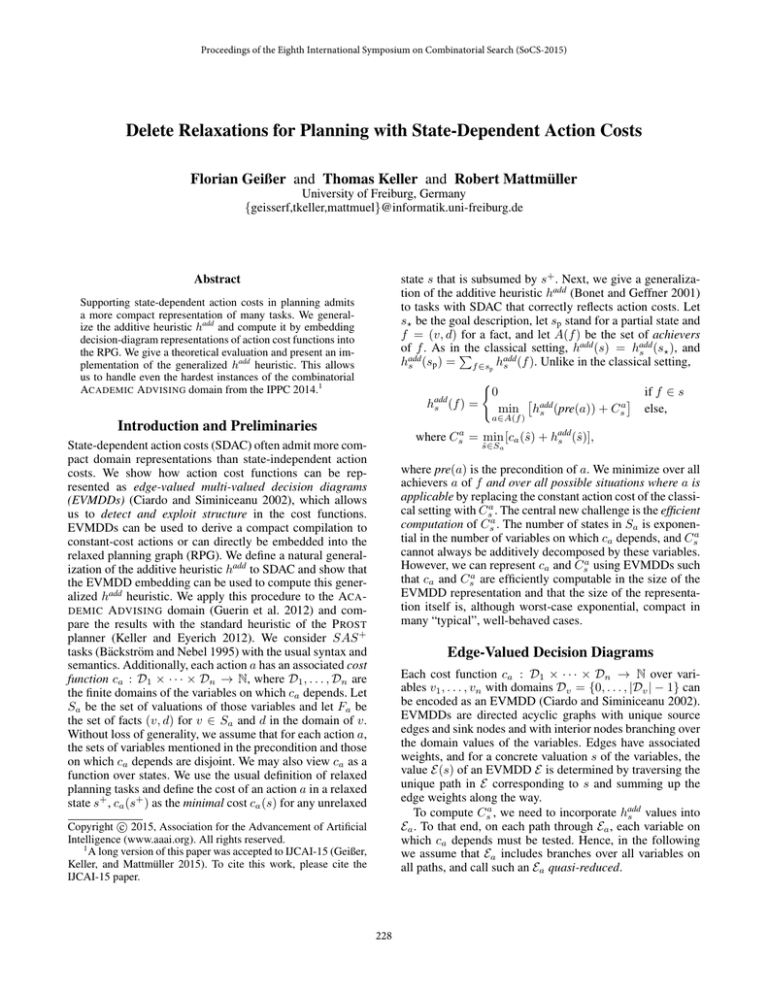
Proceedings of the Eighth International Symposium on Combinatorial Search (SoCS-2015)
Delete Relaxations for Planning with State-Dependent Action Costs
Florian Geißer and Thomas Keller and Robert Mattmüller
University of Freiburg, Germany
{geisserf,tkeller,mattmuel}@informatik.uni-freiburg.de
state s that is subsumed by s+ . Next, we give a generalization of the additive heuristic hadd (Bonet and Geffner 2001)
to tasks with SDAC that correctly reflects action costs. Let
s? be the goal description, let sp stand for a partial state and
f = (v, d) for a fact, and let A(f ) be the set of achievers
of f . As inP
the classical setting, hadd (s) = hadd
s (s? ), and
add
(s
)
=
hadd
p
s
f ∈sp hs (f ). Unlike in the classical setting,
Abstract
Supporting state-dependent action costs in planning admits
a more compact representation of many tasks. We generalize the additive heuristic hadd and compute it by embedding
decision-diagram representations of action cost functions into
the RPG. We give a theoretical evaluation and present an implementation of the generalized hadd heuristic. This allows
us to handle even the hardest instances of the combinatorial
ACADEMIC A DVISING domain from the IPPC 2014.1
hadd
s (f )
(
0
=
if f ∈ s
add
a
min hs (pre(a)) + Cs
else,
a∈A(f )
Introduction and Preliminaries
where
State-dependent action costs (SDAC) often admit more compact domain representations than state-independent action
costs. We show how action cost functions can be represented as edge-valued multi-valued decision diagrams
(EVMDDs) (Ciardo and Siminiceanu 2002), which allows
us to detect and exploit structure in the cost functions.
EVMDDs can be used to derive a compact compilation to
constant-cost actions or can directly be embedded into the
relaxed planning graph (RPG). We define a natural generalization of the additive heuristic hadd to SDAC and show that
the EVMDD embedding can be used to compute this generalized hadd heuristic. We apply this procedure to the ACA DEMIC A DVISING domain (Guerin et al. 2012) and compare the results with the standard heuristic of the P ROST
planner (Keller and Eyerich 2012). We consider SAS +
tasks (Bäckström and Nebel 1995) with the usual syntax and
semantics. Additionally, each action a has an associated cost
function ca : D1 × · · · × Dn → N, where D1 , . . . , Dn are
the finite domains of the variables on which ca depends. Let
Sa be the set of valuations of those variables and let Fa be
the set of facts (v, d) for v ∈ Sa and d in the domain of v.
Without loss of generality, we assume that for each action a,
the sets of variables mentioned in the precondition and those
on which ca depends are disjoint. We may also view ca as a
function over states. We use the usual definition of relaxed
planning tasks and define the cost of an action a in a relaxed
state s+ , ca (s+ ) as the minimal cost ca (s) for any unrelaxed
Csa
= min [ca (ŝ) + hadd
s (ŝ)],
ŝ∈Sa
where pre(a) is the precondition of a. We minimize over all
achievers a of f and over all possible situations where a is
applicable by replacing the constant action cost of the classical setting with Csa . The central new challenge is the efficient
computation of Csa . The number of states in Sa is exponential in the number of variables on which ca depends, and Csa
cannot always be additively decomposed by these variables.
However, we can represent ca and Csa using EVMDDs such
that ca and Csa are efficiently computable in the size of the
EVMDD representation and that the size of the representation itself is, although worst-case exponential, compact in
many “typical”, well-behaved cases.
Edge-Valued Decision Diagrams
Each cost function ca : D1 × · · · × Dn → N over variables v1 , . . . , vn with domains Dv = {0, . . . , |Dv | − 1} can
be encoded as an EVMDD (Ciardo and Siminiceanu 2002).
EVMDDs are directed acyclic graphs with unique source
edges and sink nodes and with interior nodes branching over
the domain values of the variables. Edges have associated
weights, and for a concrete valuation s of the variables, the
value E(s) of an EVMDD E is determined by traversing the
unique path in E corresponding to s and summing up the
edge weights along the way.
To compute Csa , we need to incorporate hadd
s values into
Ea . To that end, on each path through Ea , each variable on
which ca depends must be tested. Hence, in the following
we assume that Ea includes branches over all variables on
all paths, and call such an Ea quasi-reduced.
c 2015, Association for the Advancement of Artificial
Copyright Intelligence (www.aaai.org). All rights reserved.
1
A long version of this paper was accepted to IJCAI-15 (Geißer,
Keller, and Mattmüller 2015). To cite this work, please cite the
IJCAI-15 paper.
228
Example 1. Consider the action cost function ca = AB 2 +
C + 2 with DA = DC = {0, 1}, and DB = {0, 1, 2}.
The figure to the left shows an EVMDD
2
(not quasi-reduced) for ca and the variA
able ordering A, B, C. To see how the
1
0
0
EVMDD encodes the cost function ca ,
B
consider the valuation s with s(A) = 1,
0
0
2
1
s(B) = 2 and s(C) = 0. Traversing
1
0
4
the corresponding edges in the EVMDD
C
from top to bottom and summing up the
0
1
0
1
edge weights, we arrive at the resulting
value 6, which is exactly the cost ca (s).
0
Instance
Variables
Actions
Variables in ca
Size of Ia
IDS
hadd
0
6
∞
1
2
2
(A, 1)
(B, 0)
(B, 1)
(B, 2)
(C, 0)
(C, 1)
A
2
12 ∧ +0
12
B
+0 ∧
18
2
∨
+0 ∧
∞
+0 ∧
13
+0 ∧
8
202.19
63.41
202.90
76.15
201.67
109.02
201.51
125.52
∨
Acknowledgements. This work was partly supported by
the DFG as part of the SFB/TR 14 AVACS and by BMBF
grant 02PJ2667 as part of the KARIS PRO project. We thank
the reviewers for their insightful comments.
∧ +4
7
∨
7
+1 ∧
9
10
9
46.24
45.80
Conclusion
∧ +0
+0 ∧
0, Output
60
31
12
38 + 49
We introduced a natural extension of the definition of the
hadd heuristic to tasks with SDAC and showed how it can
be efficiently computed based on a compact encoding of action cost functions using EVMDDs. We presented an implementation of the generalized hadd heuristic in the context of
probabilistic planning and showed its efficiency.
∨
+1 ∧
∞
C
10
Experimental Evaluation
2 ∧ +2
2
8
50
26
10
32 + 41
We implemented the generalized hadd heuristic in the 2014
version of the P ROST planner (Keller and Eyerich 2012)
and compared it against the standard heuristic of P ROST on
the ACADEMIC A DVISING domain. Table 1 shows statistics for different instances. The first four rows show numbers of variables, of actions, of variables occurring in the
cost function of each action, and of nodes plus edges of
the resulting INADD. The last two rows show the average
results of P ROST across 100 runs per instance and with a
1-second timeout per planning step, for the standard IDS
heuristic used by P ROST and for the additive heuristic using the EVMDD-based RPG compilation. Both are applied
to the most-likely determinization.
Example 2. Consider the EVMDD Ea from Example 1 in
its quasi-reduced form Ea0 . The INADD Ia for Ea0 is depicted
below. Node weights are given as node annotations.
10
6
40
21
11
35 + 45
nodes from the previous layer, and the “output” node of Ia
is linked to the effect literals of a on the current layer.
To embed such an EVMDD Ea into the RPG, we need to
add “input nodes” for all relevant hadd
s values to Ea . We call
the resulting weighted directed acyclic AND/OR graph Ia
the input-node augmented decision diagram (INADD) for
Ea . We extend a given valuation ι assigning natural numbers or infinity to input nodes to a valuation ι̂ recursively by
minimization at OR nodes and summation plus addition of
node weights at AND nodes. The value of Ia for ι, Ia (ι), is
then the ι̂ value of the terminal/output INADD node.
(A, 0)
4
30
16
8
26 + 33
Table 1: Statistics of the ACADEMIC A DVISING domain.
EVMDD-Based RPG Compilation
Input
2
20
11
8
26 + 33
∨
References
The red input node labels denote ι(n) for some valuation
ι, and the red interior node labels denote the valuation ι̂.
The highlighted red path is the minimizing path determining
Ia , with used inputs also highlighted. The value Ia = 9
equals Csa = minŝ∈Sa [ca (ŝ) + hadd
s (ŝ)] if the ι values are
interpreted as hadd
values:
The
highlighted
path corresponds
s
to the minimizing ŝ, ca (ŝ) is the sum of the node weights
2 + 0 + 4 + 0 = 6 along the path, and hadd
s (ŝ) is the sum of
used input node costs, 0 + 1 + 2 = 3.
Bäckström, C., and Nebel, B. 1995. Complexity Results for
SAS+ Planning. Computational Intelligence 11:625–656.
Bonet, B., and Geffner, H. 2001. Planning as heuristic
search. Artificial Intelligence (AIJ) 129:5–33.
Ciardo, G., and Siminiceanu, R. 2002. Using edge-valued
decision diagrams for symbolic generation of shortest paths.
In Proc. FMCAD 2002, 256–273.
Geißer, F.; Keller, T.; and Mattmüller, R. 2015. Delete relaxations for planning with state-dependent action costs. In
Proc. IJCAI 2015. To appear.
Guerin, J. T.; Hanna, J. P.; Ferland, L.; Mattei, N.; and Goldsmith, J. 2012. The academic advising planning domain. In
Proc. IPC Workshop at ICAPS 2012.
Keller, T., and Eyerich, P. 2012. PROST: Probabilistic Planning Based on UCT. In Proc. ICAPS 2012.
Theorem 1. Let Ia be the INADD for a quasi-reduced
EVMDD Ea encoding the action cost function ca of action
a. Let the ι values of input fact nodes be hadd
s (f ) for all facts
f ∈ Fa . Then Ia (ι) = Csa .
In each RPG layer, we can embed an action sub-graph
for a that is the “conjunction” of Ia with the precondition
facts of a. The input nodes of Ia are the corresponding fact
229




